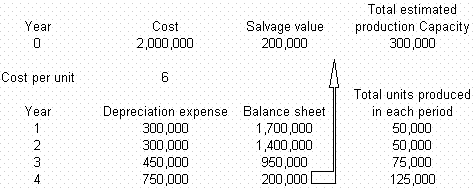CFA Level 1 - Assets
Depreciation is defined as the reduction in the value of a product arising from the passage of time due to use or abuse, wear and tear. Depreciation is not a method of valuation but of cost allocation. This cost allocation can be based on a number of factors, but it is always related to the estimated period of time the product can generate revenues for the company (economic life). Depreciation expense is the amount of cost allocation within an accounting period. Only items that lose useful value over time can be depreciated. That said, land can't be depreciated because it can always be used for a purpose.
Straight-line Depreciation
The simplest and most commonly used method, straight-line depreciation is calculated by taking the purchase or acquisition price of an asset, subtracting by the salvage value (value at which it can be sold once the company no longer needs it) and dividing by the total productive years for which the asset can be reasonably expected to benefit the company, or its useful life.
Example: For $2m, Company ABC purchased a machine that will have an estimated useful life of five years. The company also estimates that in five years, the company will be able to sell it for $200,000 for scrap parts.
Formula 8.4
Depreciation expense
= total acquisition cost - salvage value
useful life
Unit-of-production Depreciation
This method provides for depreciation by means of a fixed rate per unit of production. Under this method, one must first determine the cost per one production unit and then multiply that cost per unit with the total number of units the company produced within an accounting period to determine its depreciation expense.
Formula 8.5
Depreciation expense
= total acquisition cost - salvage value
useful life
Know that this method of depreciation produces a constant depreciation expense, and at the end of its useful life, this asset will be accounted for in the balance sheet at its salvage value.
|
Unit-of-production Depreciation
This method provides for depreciation by means of a fixed rate per unit of production. Under this method, one must first determine the cost per one production unit and then multiply that cost per unit with the total number of units the company produced within an accounting period to determine its depreciation expense.
Formula 8.5
Depreciation expense = total acquisition cost - salvage value
estimated total units
Estimated total units = the total units this machine can produce over its lifetimeDepreciation expense = depreciation per unit * number of units produced during an accounting period
Example:
Company ABC purchased a machine that can produce 300,000 products over its useful life for $2m. The company also estimates that this machine has a salvage value of $200,000.
estimated total units
Estimated total units = the total units this machine can produce over its lifetimeDepreciation expense = depreciation per unit * number of units produced during an accounting period
Example:
Company ABC purchased a machine that can produce 300,000 products over its useful life for $2m. The company also estimates that this machine has a salvage value of $200,000.
 |
Know that this depreciation method produces a variable depreciation expense and is more reflective of production-to-cost (matching principle).
|
At the end of the useful life of the asset, its accumulated depreciation is equal to its total cost minus its salvage value. Furthermore, its accumulated production units equal the total estimated production capacity. One of the drawbacks of this method is that if the units of products decrease (slowing demand for the product), the depreciation expense also decreases. This results in an overstatement of reported income and asset value.
Hours-of-service Depreciation
This is the same concept as unit of production depreciation except that the depreciation expense is a function of total hours of service used during an accounting period.
Hours-of-service Depreciation
This is the same concept as unit of production depreciation except that the depreciation expense is a function of total hours of service used during an accounting period.







0 comments:
Post a Comment